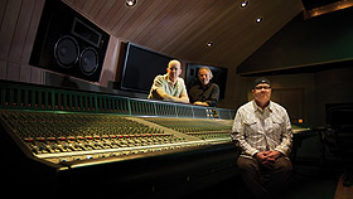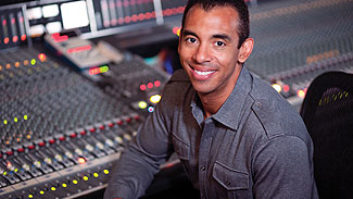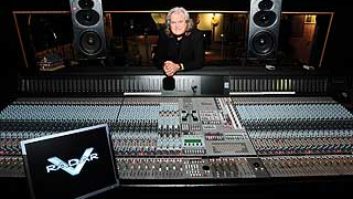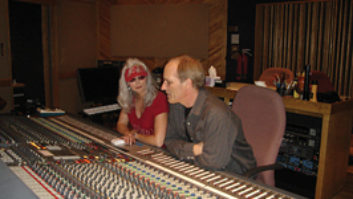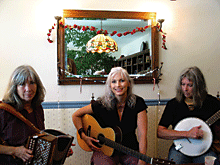
Anna McGarrigle (button accordion) and Kate McGarrigle (banjo) tracking with Emmylou Harris
Photo: Rick Clark
Few artists in any genre have created a body of work as substantive and rich as Emmylou Harris. Over the years, Harris has mined great songs from folk, country and pop music traditions and showcased their compelling power with her own unique readings. She has also been a selfless champion of many artists and writers, and has written a number of superior songs herself. Harris has received many awards for her work, and this year she was inducted into the Country Music Hall of Fame.
Harris’ string of hits stretches back to 1975, when she began working with producer Brian Ahern on a successful run of 11 albums that included a number of classic tracks and hits like “Together Again,” “Boulder to Birmingham,” “Sweet Dreams,” “If I Could Only Win Your Love,” “Two More Bottles of Wine,” “Beneath Still Waters” and “Too Far Gone.” White Shoes, which was released 25 years ago, was the last album the two made together. Since then, Harris has put out many fine and critically acclaimed albums, but it is her work with Ahern that has proven to be the most influential and enduring over time.
During the past few years, Harris and Ahern have occasionally revisited their creative dance, and most recently it has resulted in a beautiful new release titled All I Intended to Be. The seeds for this new collaboration began during a reunion of Harris’ legendary Hot Band for the 2004 ASCAP Country Music Awards show, where Harris was presented with the Founders Award.
“Since the award was about history, she asked me to come in to supervise the rehearsal and to re-create the Hot Band session vibe,” Ahern explains. “After the show, we were sitting at dinner when she asked me to do another album.”
By that time, the two had already reunited for a number of recordings for various projects: Robert Redford and Ethan Hawke movies, duets with Willie Nelson and Rodney Crowell, and, with Kate and Anna McGarrigle, three songs for the re-issue of Harris’ luminous Christmas album Light of the Stable. Especially moving was her version of Joni Mitchell’s “The Magdalene Laundries” and a richly imagistic track called “The Connection,” which appeared on The Very Best of Emmylou Harris: Heartaches and Highways, and earned Harris a 2005 Grammy for Best Female Country Vocal Performance.
“We’ve always worked incredibly well together,” says Harris. “Even from those first sessions, when I was so unsure of myself, it wasn’t long for me to feel comfortable because one of Brian’s many talents is his ability to sense an artist’s strengths and encourage them without putting you on the spot. He allows you to grow at your own pace and gives you just enough room so that you don’t hang yourself, but you also start to get confidence. I really think Brian understands that every artist is completely unique and has a vision down there somewhere. He helps you discover that by giving you all the tools. I felt I had a safety net, that he was listening to everything, and sometimes just him not saying anything was exactly what you needed. It’s a very nurturing presence.”
All I Intended to Be celebrates some of the people who have journeyed with Harris over the years on her artistic path, including Dolly Parton, Vince Gill and musicians Glen D. Hardin, Stuart Duncan, Steve Fishell, Richard Bennett (who has produced Harris) and the Seldom Scene. The album also showcases Harris’ talent for gatherering great songs, as well as her own gifts as a songwriter.
Harris has long kept a huge library of stashed song-finds on what she calls “material cassettes,” and as always she shows her extraordinary knack for taking others’ songs and making them feel like they came from her heart. Ahern’s empathetic production and arrangements go a long way to making All I Intended to Be one of the most emotionally satisfying albums Harris has done in years.
Six of the tracks on the new album are Harris’ own compositions. This is an area where she has shown tremendous growth during the past several years, as her songs on Red Dirt Girl and Stumble Into Grace show. One song of All I Intended to Be, titled “Gold,” is a stripped-down “three chords and the truth” gem of classic country. “Those are the hardest songs to write,” she comments, “because you’re working in a very small framework and you can’t get clever. You have to come out and say exactly what you mean.”
Most of the work on All I Intended to Be took place at Ahern’s Easter Island Surround studio, which got its name from the 8-foot stacks of gear that surround the control room like the ancient Pacific Island statues. Among the projects Ahern has done there are Harris’ Producer’s Cut (a DVD-Audio surround collection of classic Harris tracks) and surround mixes for Johnny Cash and three Jimmy Buffett DVDs.
Looming behind the studio is the legendary 42-foot, lead-lined Enactron truck. Deployed for all the great Harris productions, it was also a highly sought-after mobile facility used by such diverse acts as Black Sabbath, Bob Dylan, Barbra Streisand and James Taylor.
Even with these options, however, several basic tracks on Harris’ latest required a larger band, and for those Ahern booked the Sound Emporium in Nashville, where he produced Ricky Skaggs and a Number One country record for Johnny Cash. “I like recording at home, but not playing host,” says Ahern. “So when the contingent exceeds two people, I book a studio.” Ahern mounted his 16-track headstack on Sound Emporium’s Studer A827 to record bass and drums at 15 ips on 14-inch reels. “I like to use 14-inch reels because it cuts down on tape waste, and while you are changing smaller reels, the best performances could be slipping away.”
Another member of the creative team who has contributed to the excellence of this new album, as well as most of Ahern’s productions since 1975, is engineer/mixer Donivan Cowart. “Donivan puts up with me. I’m getting old and irascible,” states Ahern. “But the common lingo tends to build after 30 years. He’s become an irreplaceable asset.”
To ensure that there would be plenty of creative sparks, Ahern brought in a group of world-class players. He notes wryly, “If you are the smartest person in the room, you’re working with the wrong people.” Musicians included original Hot Band member Glenn D. Hardin (keys), Glen Worf (bass), Harry Stinson (drums), Richard Bennett (guitar) and Kenny Vaughan (guitar).
Ahern miked Worf’s upright bass with his rare, large British ribbon mic called a Reslo right off the bridge to achieve what he calls “knuckles — you could hear what Glen had for lunch.” The Reslo ran through a Neve 1084 mic pre and was lightly compressed with an LA-2A. An RCA 44 was placed on the floor looking up at the bass with a big block of foam behind it so the backside of the mic heard nothing. That ran through a Tube-Tech CL1B compressor. “Glen finds a way to be musical with one note at a time,” says Ahern admiringly. The producer places his microphones on Gramma insulating floor risers designed to hold guitar amplifiers.
Guitarist Bennett was situated in an all-wood room designed for string sections with four bidirectional ribbon mics to capture his sound. According to Sound Emporium engineer Kyle Ford, “For the close stereo sound, Brian hung two RCA Varicoustics on the only stereo bar I’ve ever seen like this — at different heights, on the 12th fret and at the sound hole. Brian had Richard face the curved wood wall, where he spread out a pair of Wes Dooley’s AEA R44 CNEX microphones. Huge vintage Turner hybrid microphones faced Kenny Vaughn’s amplifiers, which included Brian’s Space Echo feeding his Fender Deluxe.”
Stinson, one of Nashville’s consummate session drummers, observes, “The first question Brian asked when he hired me was, ‘Where do you want to be set up?’ That question never gets asked! Nothing about this was typical Nashville. Emmy and Brian still like to approach music as an art form, whereas Nashville — if I can make a political statement — is about doing it quick, fast, formula: ‘Let’s go with all these plug-ins.’”
Stinson also overdubbed drums at Ahern’s house. “When Harry is overdubbing to something previously recorded, he can hear, sympathize and play through the center of the mayhem,” says Ahern.
Final overdubs took place at The Village in West L.A., where Ahern had been working with an all-star band on another project. “Emmy’s album still felt sleepy, so I peeled off two of my ringers to contribute”: Greg Leisz and Patrick Warren for stringed instrumental overdubs and keyboards, respectively.
“Brian can walk the line between allowing you to instinctually do what you do to a song and also knowing how to get what he wants out of that person by just a few carefully chosen words of direction here and there,” says Leisz. “It’s a really good combination for somebody like me, and I think it’s a really important part of what he does as a producer. I think to be completely left alone without any direction at all is sometimes frustrating because you want a little bit of feedback.”
“On rare occasions, a producer may superimpose [his own vision],” Ahern adds. “‘Broken Man’s Lament’ is a song about a mechanic who lost his wife to her singing career. To me, he obsesses on a piece of music as an artifact of his creeping insanity. I explained this to Patrick Warren who researched the ‘Whiter Shade of Pale’ B-3 organ drawbar settings.
“Extracting the best performances is Job Number One,” Ahern continues. “Great headphones, if you’re using them, are essential. We dedicated two MacIntosh MC-275 tube amps, our finest, to the headphone mixes. Everybody hears really well.”
One element that leaves a sonic fingerprint on this album is Ahern’s pervasive use of ribbon mics. “Brian has more ribbon mics than anyone I’ve ever met,” remarks engineer Ford. “He carries around a number of rare, hard-to-find mics, as well as some newer ones. I had never heard the Turners and Reslos.”
For Harris’ vocals, Ahern says, “Because recording up close to a microphone is a relatively modern concept, vintage ribbon mics are susceptible to pops and breaths. I told Wes we liked his AEA R84, but I couldn’t use it because Emmy kept sneaking up on it. He built one to accommodate us. And his ribbon preamplifier was everywhere. When Vince [Gill] and Dolly [Parton] sang harmonies on ‘Gold,’ I used his big AEA 44 Cs. Dolly said, ‘I love this microphone,’ so we gave it to her!”
Dooley’s R44 CNEX was used to record Harris’ bluegrass buddies, the Seldom Scene. “Live in the room, she used a Soundelux U67. I often choose it for contralto females,” Ahern says.
Ahern and Cowart are both fond of Harris’ aggressive guitar style. Harris clearly loves playing guitar, and Ahern hired her to play on Keith Richards’ contribution to George Jones’ Bradley’s Barn Sessions album. “I do enjoy playing rhythm guitar,” Harris says. “I think it’s just connected to you. That’s how I learn songs: I sit down and play them on the guitar so the phrasing and the heartbeat are connected with the guitar. I find my voice through the guitar, in a way. I’m perfectly happy to have my own little picker’s corner where I’m comfortable.” For Harris’ guitar on this album, they sometimes used an AKG C-24 in an M/S configuration and at other times one of four RCA Type BK-5Bs.
For mic pre’s for ribbons, Cowart and Ahern also liked one made by Wes Dooley. “It works well: You set it up right by the ribbon mic and amplify it before you make a long run into the studio with it,” explains Cowart. “It helps hold the gain together; it has lots of gain and low noise.”
Over the course of the project, Ahern and Cowart used some other favorite pieces of gear one might not expect. “We have a discontinued Yamaha reverb unit Keith Richards showed me in New York that provides convolution presets of a wood-domed studio,” says Ahern. “We also used it to take quad convolution recordings of the soon-to-be extinct Lexicon 224XL. We used two low-bit Prime Times. And the Germanium Tone Control and the Zener Limiter seem to be in successful pursuit of the best vintage sonic markers and character that we’ve come to know and love over the last 40 years.”
In a time when so many records sound like the life has been squashed out of them from overcompression, Ahern’s productions are rich in dynamics. Vocals and instruments rise and fall naturally, enticing the listener to ride with the feeling of the moment.
“That’s the emotion, and the dynamics has a lot to do with the emotion,” says Cowart. “If you suck all that out, you’re just left with noise. I’d much rather have somebody have to lean into the mix than be blown against the back wall.”
Ahern adds, “It provides a sense of people being together in a room rather than rash waveforms. We don’t use any stereo gain reduction. Let mastering do that.”
Georgetown Masters’ Andrew Mendelson mastered the album; he remarks that All I Intended to Be is an exceptionally “emotional” album that has “loads of vibe and makes no concessions to the highly compressed sound of what you hear today,” he says. “As a result, it stands out and sounds totally fresh.”
“Working with Brian and Donivan gives me everything I need and lets me know when it’s not happening,” Harris concludes. “If you’re sounding good to yourself, you’re going to stop thinking, worrying and just sing. They’re also very patient. I feel more comfortable having that working relationship, that sort of ‘nest’ where you know everything’s gonna be okay. I think we got to that point a long time ago and we sort of picked up where we left off.”
